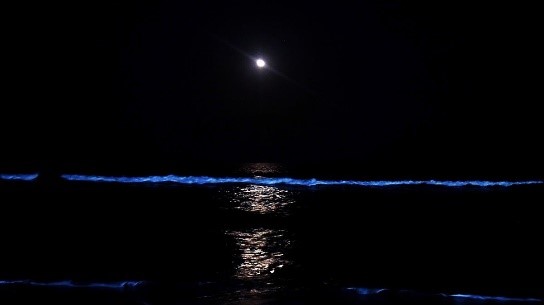BIOLUMINESCENCE
BIOLUMINESCENCE

Why in news?
Adequate nutrients brought by substantial rain and a high abundance of the plankton, called diatom Thalassiosira sp. triggered the (bioluminescent) bloom of Noctiluca scintillans, says a study done by the National Centre for Coastal Research (NCCR).
Highlights:
- The plankton is available in the ocean and due to nutrition available, it will multiply and becomes the bloom.
- Low wind speed, lowering of atmospheric temperature, high rain and low sea surface temperature are cited as probable environmental cues.
- Local hydrodynamics and the diverging currents governed the presence and dispersion of the sudden outbreak of the bioluminescent dinoflagellate Noctiluca scintillans bloom in the region.
- The paper, which was written by Pravakar Mishra, Mehmuda Begum, Anitha Gera and others and published recently in the scietific journal Oceanologia, focused on the occurrence of bloom along a 16-km stretch following a spell of heavy rain in August 2019.
- The paper explained that once the bloom reduces, there is an increase in bacterial population associated with the phyto-plankton bloom. The lowest count was recorded on the Panaiyurkuppam beach and the maximum on Elliot’s Beach. Total coliform too was recorded in the waves.
- Bioluminescence was observed owing to turbulence and intense wave breaking in the surf zone, stimulating bioluminescence in Noctiluca scintillans cells. Within two days after the appearance of bioluminescence, the blooming cells slowly degenerated and moved away by the current, and finally declined.
What is Bioluminescence?
- Bioluminescence is the property of a living organism to produce and emit light. Animals, plants, fungi and bacteria show bioluminescence. A remarkable diversity of marine animals and microbes are able to produce their own light. It is found in many marine organisms such as bacteria, algae, jellyfish, worms, crustaceans, sea stars, fish and sharks. Luminescence is generally higher in deep-living and planktonic organisms than in shallow species.
- Bioluminescence is an amazing natural phenomenon in which an organism produces and emits light due to a chemical reaction where the chemical energy is converted into light energy. Bioluminescence occurs due to a chemoluminescence reaction, where the enzyme luciferase catalyses the pigment luciferin. Energy is utilized in most of the reactions.
- The reaction takes place inside or outside the cell. Many organisms produce luciferase which helps them to accelerate the rate of reaction. Some organisms bind oxygen with luciferin in a photoprotein. It lights up the moment some ion is present.
Dinoflagellates –
-
Also known as the fire algae, they are a kind of unicellular algae that are found inhabiting both in freshwater and marine ecosystems. These entities are capable of bioluminescence as they produce a chemical compound which has the potential to generate light when they react. The process is stimulated when dinoflagellates come in contact with any object, other organisms or even water movement through waves. They can also glow due to a dip in the temperature. They use the process of bioluminescence as a defensive mechanism from the predators. On lighting up, these entities produce a glowing blue colour.

